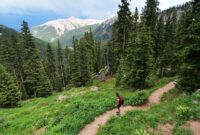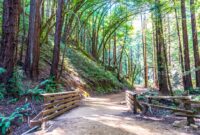Trails and hikes near me offer a gateway to exploration, fitness, and relaxation. Whether you’re a seasoned hiker seeking challenging climbs or a casual walker looking for a peaceful stroll, the diverse options available cater to a wide range of preferences and fitness levels. This exploration delves into finding the perfect trail for your needs, considering factors like location, difficulty, and personal preferences, ensuring a safe and enjoyable outdoor experience.
From utilizing location services to discover nearby trails to understanding the importance of detailed trail descriptions and user reviews, this guide aims to equip you with the knowledge and tools to plan your next outdoor adventure effectively. We’ll cover everything from safety precautions to nearby complementary activities, transforming your search for “trails and hikes near me” into a seamless and rewarding journey.
Locational Data and Search Results
Locational data is fundamental to a successful hiking app or website. It allows users to find trails near them, filter results based on proximity, and plan their outings effectively. Accurate and efficient processing of location information significantly enhances the user experience, transforming a simple trail listing into a personalized adventure planning tool.
The impact of location services on search results is profound. Without location data, a search for “hiking trails” would return a vast, unmanageable list of trails globally. However, by incorporating the user’s location (obtained through GPS or IP address), the search is refined to display trails within a specified radius, prioritizing those closest to the user. This dramatically improves relevance and usability. For example, a user in Denver, Colorado searching for “easy hikes” would receive results for trails in and around Denver, rather than trails in Yosemite National Park.
Location-Based Information Presentation
Several methods effectively present location-based information to users. Map integration is arguably the most intuitive. A visual map displaying trail locations, overlaid with points of interest like trailheads, campsites, or water sources, provides a clear and comprehensive overview. This allows users to quickly assess the trail’s location relative to their current position and other landmarks. Address details, including street addresses for trailheads, are crucial for users relying on navigation apps like Google Maps or Apple Maps to reach their starting points. Providing both latitude and longitude coordinates can further enhance accuracy for GPS devices. Finally, a combination of map and textual information provides a robust and accessible presentation.
Hiking Trail User Interface Design
The following table illustrates a user interface design for showcasing various hiking trails. It uses a responsive design, adapting to different screen sizes. Estimated times are based on average hiking speeds, accounting for variations in terrain and elevation changes. Difficulty levels are categorized as Easy, Moderate, and Hard, using widely accepted standards.
| Trail Name | Distance (miles) | Difficulty | Estimated Time (hours) |
|---|---|---|---|
| Red Rock Canyon Trail | 3.5 | Moderate | 2-3 |
| Eagle Peak Trail | 6.0 | Hard | 4-5 |
| Willow Creek Loop | 1.8 | Easy | 1-2 |
| Mount Baldy Trail | 8.2 | Hard | 5-7 |
Visual Presentation of Trails
A compelling visual presentation of trails is crucial for attracting hikers and providing them with a realistic preview of their potential adventure. High-quality imagery, encompassing diverse perspectives and atmospheric details, can significantly enhance the user experience and encourage exploration. This section will detail the visual aspects of various trail types, emphasizing the elements that contribute to a rich and immersive experience.
Mountain Peak Panorama
Imagine standing atop a granite peak, the wind whipping through your hair. Before you stretches a breathtaking panorama. To the west, a vast expanse of rolling hills, cloaked in a vibrant tapestry of green and gold, extends to the hazy horizon. Closer, the slopes are a patchwork of coniferous forests, punctuated by the occasional rocky outcrop. The air is crisp and clean, carrying the faint scent of pine and damp earth. A few wispy clouds drift lazily across a sky of brilliant blue, their shadows dancing across the landscape below. The overall atmosphere is one of majestic solitude and profound tranquility, the sense of scale amplified by the sheer drop-off at the edge of the peak. In the distance, the faint shimmer of a distant lake reflects the sunlight, adding a touch of ethereal beauty to the scene. The weather is clear and sunny, though a hint of chill lingers in the air.
Forest Trail Visuals
A forest trail offers a completely different visual experience. The air is thick with the earthy scent of decaying leaves and damp soil, mingled with the sweet fragrance of wildflowers blooming along the trail’s edge. The sounds of the forest are equally captivating: the rustling of leaves in the gentle breeze, the chirping of unseen insects, and the occasional call of a distant bird. The trail itself is shaded and cool, the sunlight filtering through a dense canopy of trees. The textures are varied – the soft, yielding earth underfoot, the rough bark of ancient trees, the smooth, cool surfaces of moss-covered rocks. The dappled light creates an enchanting play of shadows and highlights on the forest floor, enhancing the sense of mystery and seclusion. The trail winds gently through the undergrowth, offering glimpses of sunlight filtering through the trees and glimpses of wildlife, possibly a squirrel scampering up a tree trunk or a deer quietly grazing in a clearing.
Trail Suitable for 360° Virtual Tour
A trail ideally suited for a 360° virtual tour would be one that offers a diverse range of visual elements within a relatively compact area. A trail that meanders along a riverbank, passing through varied terrain, such as meadows, forests, and rocky outcrops, would be perfect. The trail should be relatively well-maintained and free of significant obstacles, ensuring a smooth and safe virtual experience. Ideally, the trail would offer views of interesting landmarks, such as waterfalls, bridges, or historical structures, to provide visual interest and a sense of place. The inclusion of diverse flora and fauna would also enhance the overall experience, offering viewers a glimpse into the local ecosystem. The lighting conditions should be considered, with the optimal time for filming being during the golden hour for the most visually appealing results. This combination of varied landscapes, points of interest, and good lighting would create a truly immersive and engaging virtual tour.
Related Activities and Services
Exploring the trails near you doesn’t have to end with the hike itself. Many complementary activities and services enhance the overall experience, transforming a day trip into a memorable adventure. This section outlines nearby options to consider before, during, or after your hike, ensuring a well-rounded and enjoyable outing.
Extending your outdoor experience beyond the trails opens up a world of possibilities, from relaxing post-hike meals to thrilling activities that build upon the hiking experience. Furthermore, access to convenient services can significantly improve your comfort and safety.
Nearby Activities Complementing Hiking
Many activities naturally complement a day of hiking. These options provide opportunities for relaxation, further exploration, or simply a change of pace.
- Camping: Establish a basecamp near your chosen trail for a multi-day adventure. This allows for a more immersive experience, allowing you to enjoy the area’s natural beauty at a slower pace. Imagine waking up to the sounds of nature, having a leisurely breakfast, and then embarking on your hike, fully refreshed.
- Wildlife Viewing: Many hiking trails offer excellent opportunities for wildlife viewing. Remember to maintain a safe distance and observe animals without disturbing their natural behavior. Binoculars can significantly enhance your wildlife viewing experience, allowing you to spot birds, mammals, and other creatures from afar.
- Local Restaurants: After a rewarding hike, treat yourself to a delicious meal at a local restaurant. Support local businesses and savor the flavors of the region. Look for establishments known for their fresh, locally-sourced ingredients. A hearty meal can provide the perfect post-hike refueling.
Gear Rental and Guided Tours
Accessing necessary equipment and expert guidance can significantly enhance your hiking experience, particularly for beginners or those tackling challenging trails.
- Gear Rental: If you lack specific hiking gear, several local outfitters rent equipment such as backpacks, hiking boots, trekking poles, and camping gear. This eliminates the need for significant upfront investment, making hiking accessible to a wider range of people. Renting allows you to try different gear before committing to a purchase.
- Guided Tours: Consider joining a guided tour for a more structured and informative experience. Guided tours often provide valuable insights into the local flora, fauna, and history, enhancing your understanding and appreciation of the area. Guided tours can also increase safety, especially in remote or challenging terrains. Experienced guides can navigate difficult trails and provide essential safety tips.
Ending Remarks
Ultimately, discovering trails and hikes near you is about more than just physical activity; it’s about connecting with nature, pushing personal boundaries, and creating lasting memories. By understanding your needs, utilizing available resources, and prioritizing safety, you can unlock a world of outdoor adventures right at your doorstep. Embrace the journey, explore the trails, and discover the hidden gems waiting to be explored in your local area. Happy hiking!




